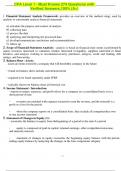Exam (elaborations)
CFA( Chartered Financial Analyst )Level 1 2024 Questions & Verified Answers
- Course
- Institution
1. Financial Statement Analysis Framework: provides an overview of the method- ology used by analysts to consistently analyze financial statements a) articulate the purpose and context of analysis b) collecting data c) process the data d) analyzing and interpreting the processed data e) develo...
[Show more]



